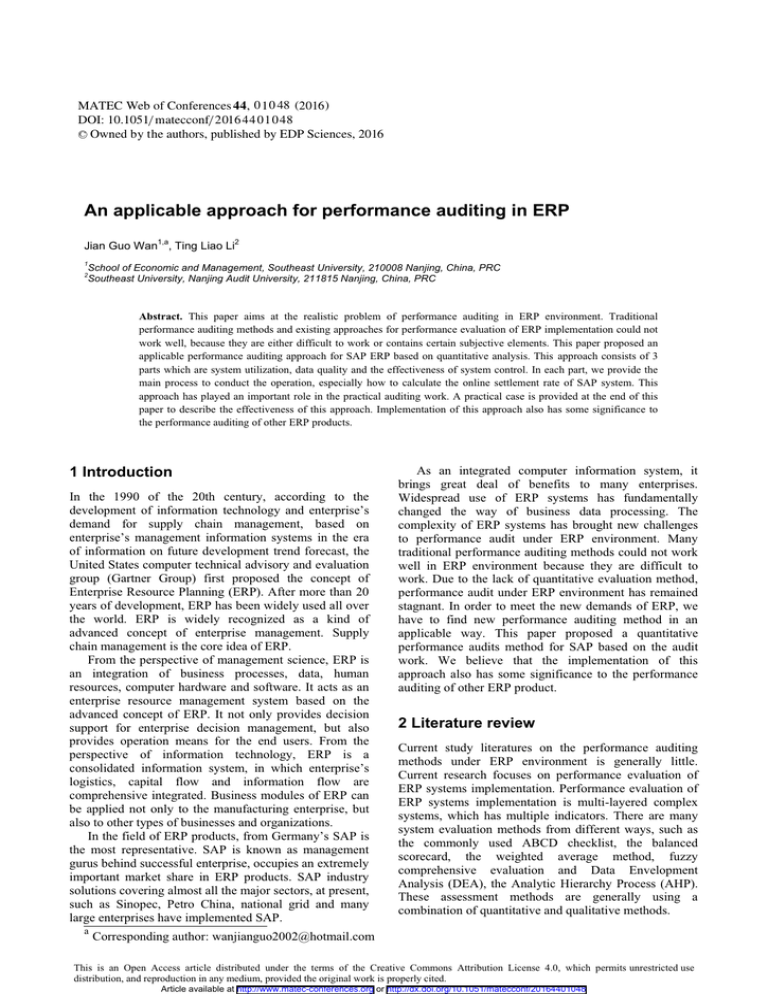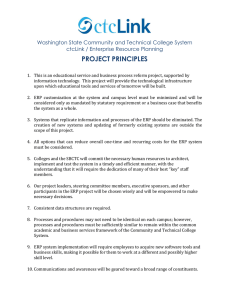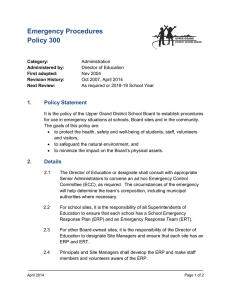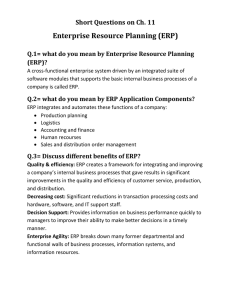An applicable approach for performance auditing in ERP
advertisement

MATEC Web of Conferences 4 4, 0 1 0 48 (2016 ) DOI: 10.1051/ m atecconf/ 2016 4 4 0 1 0 48 C Owned by the authors, published by EDP Sciences, 2016 An applicable approach for performance auditing in ERP Jian Guo Wan1,a, Ting Liao Li2 1 School of Economic and Management, Southeast University, 210008 Nanjing, China, PRC Southeast University, Nanjing Audit University, 211815 Nanjing, China, PRC 2 Abstract. This paper aims at the realistic problem of performance auditing in ERP environment. Traditional performance auditing methods and existing approaches for performance evaluation of ERP implementation could not work well, because they are either difficult to work or contains certain subjective elements. This paper proposed an applicable performance auditing approach for SAP ERP based on quantitative analysis. This approach consists of 3 parts which are system utilization, data quality and the effectiveness of system control. In each part, we provide the main process to conduct the operation, especially how to calculate the online settlement rate of SAP system. This approach has played an important role in the practical auditing work. A practical case is provided at the end of this paper to describe the effectiveness of this approach. Implementation of this approach also has some significance to the performance auditing of other ERP products. 1 Introduction In the 1990 of the 20th century, according to the development of information technology and enterprise’s demand for supply chain management, based on enterprise’s management information systems in the era of information on future development trend forecast, the United States computer technical advisory and evaluation group (Gartner Group) first proposed the concept of Enterprise Resource Planning (ERP). After more than 20 years of development, ERP has been widely used all over the world. ERP is widely recognized as a kind of advanced concept of enterprise management. Supply chain management is the core idea of ERP. From the perspective of management science, ERP is an integration of business processes, data, human resources, computer hardware and software. It acts as an enterprise resource management system based on the advanced concept of ERP. It not only provides decision support for enterprise decision management, but also provides operation means for the end users. From the perspective of information technology, ERP is a consolidated information system, in which enterprise’s logistics, capital flow and information flow are comprehensive integrated. Business modules of ERP can be applied not only to the manufacturing enterprise, but also to other types of businesses and organizations. In the field of ERP products, from Germany’s SAP is the most representative. SAP is known as management gurus behind successful enterprise, occupies an extremely important market share in ERP products. SAP industry solutions covering almost all the major sectors, at present, such as Sinopec, Petro China, national grid and many large enterprises have implemented SAP. a As an integrated computer information system, it brings great deal of benefits to many enterprises. Widespread use of ERP systems has fundamentally changed the way of business data processing. The complexity of ERP systems has brought new challenges to performance audit under ERP environment. Many traditional performance auditing methods could not work well in ERP environment because they are difficult to work. Due to the lack of quantitative evaluation method, performance audit under ERP environment has remained stagnant. In order to meet the new demands of ERP, we have to find new performance auditing method in an applicable way. This paper proposed a quantitative performance audits method for SAP based on the audit work. We believe that the implementation of this approach also has some significance to the performance auditing of other ERP product. 2 Literature review Current study literatures on the performance auditing methods under ERP environment is generally little. Current research focuses on performance evaluation of ERP systems implementation. Performance evaluation of ERP systems implementation is multi-layered complex systems, which has multiple indicators. There are many system evaluation methods from different ways, such as the commonly used ABCD checklist, the balanced scorecard, the weighted average method, fuzzy comprehensive evaluation and Data Envelopment Analysis (DEA), the Analytic Hierarchy Process (AHP). These assessment methods are generally using a combination of quantitative and qualitative methods. Corresponding author: wanjianguo2002@hotmail.com This is an Open Access article distributed under the terms of the Creative Commons Attribution License 4.0, which permits XQUHVWULFWHGXVH distribution, and reproduction in any medium, provided the original work is properly cited. Article available at http://www.matec-conferences.org or http://dx.doi.org/10.1051/matecconf/20164401048 MATEC Web of Conferences Zhang Hui, Mou Yankui (2009) performed metric analysis from multiple angles on the results of ERP implementation, using ABCD check table. They provided assessment scores to the running situation of enterprise’s ERP system according to 4 aspects and 25 questions respectively. These aspects contain technology, data integrity, education and training, and system usage. According to the degree of performance for each items, different scores are given (excellent 4 points, good 3 points, medium 2 points, poor 1 points, not implementation 0 points). The cumulative total 90 points above of determine for A level, 71~90 points determine for B level, 50~70 identified as C level, less than 50 points identified as D level. According to different levels of results (ABCD), a qualitative description and conclusions can be provided. Ma Guangqing (2009) using the weighted average method which is simple and intuitive, from technical capacity, managerial capacity and elements of efficiency evaluation, construct a set of index system of performance evaluation for ERP system implementation. The evaluation model and its solution are given on this basis. This method uses AHP method to determine the relative weight of each index based on experts’ scores. Zou Mingxin, and Xu Xuejun (2006) proposed a three-layer index system based on the balanced scorecard to evaluate the performance of ERP implementation combined with the overall goals of ERP implementation. They also used expert comprehensive evaluation method for example of application. Sun Yuefan, Zhang Zhenhao (2007) conducted a quantitative research on how investment of ERP affects the economic efficiency and competitive of enterprises based on DEA model. This provides a possible idea for study on performance evaluation of ERP investment. Analytic Hierarchy Process (AHP) is a common method of performance evaluation of ERP, which is discussed in many literatures. The key point of Analytic Hierarchy Process is to establish the index system and determine the standard points of each indicator. It is a subjective and an objective, quantitative and qualitative methods. There are some empirical researches on ERP performance. Zheng Chende, Chen Jinyong, and WangYan (2008) took listed enterprises which implemented ERP as samples to study the impact of ERP implementation on the performance of State-owned enterprises. Empirical results show that ERP systems can improve the operation of State-owned enterprises. Inventory turnover, accounts receivable turnover, turnover and total assets turnover were all increased significantly after the ERP implementation. ERP system can effectively improve the productivity of workers, reducing the number of employees; but the profitability of State-owned enterprises is not increased after the implementation of ERP system. Xu Ming (2010) took manufacturing listed companies in Shanghai and Shenzhen as the research object, conducting an empirical research on how the implementation of ERP systems affects the performance of listed companies. Research showed that, implementation of ERP does help to improve enterprise’s operating performance, and affect financial performance index such as assets turnover and inventory turnover. Improved performance of enterprise through the implementation ERP has time lag effect. It always needs 3 to 4 years of using to gain the effect of ERP. In short-term view, enterprise using domestic ERP system would improve its benefits faster than enterprise using foreign ERP systems, but from long-term view, Indicators of enterprises using foreign ERP systems is superior to the using domestic ERP systems. Li Benbo, ChenSheng, and Qiang Haitao (2006) used 87 valid questionnaires from 30 small and medium enterprises in Chongqing for empirical research. Results showed that quality of members in project team, budget, enterprise management, ERP project implementation are significant factors of the performance of ERP implementation. Quality of project members is the fundamental factor, and software selection and performance of ERP implementation has no significant positive relationship. Existing approaches for performance evaluation of ERP implementation can be little help to performance auditing under ERP environment. First of all, because these approaches contain certain subjective elements (such as the construction of index system), and even adopt the experts’ advice cannot eliminate subjectivity. On the contrary, audit evidence is required to be objective. Therefore, these methods are rarely used. Secondly, these methods are systematic evaluation method, which needs large collection of information, and has a long period of data acquisition and processing. It is difficult to meet the requirements of the time limit for the field audit. An objective, quantitative audit approach is urgently needed in the performance audit process under ERP environment. 3 Applicable performance approach of SAP auditing Through the study of auditing work, we summarized 3 parts of the performance indicators in ERP system according to the feature of SAP. Quantitative performance audit methodology for SAP consists of system utilization, data quality and the effectiveness of system control. System utilization consists of 2 aspects, which are the condition of user login and online settlement rate. Data quality consists of master data quality and interface data quality. Effectiveness of system control consists of the achievement of key business controls and the validity of control data. 3.1 System utilization System utilization is the most intuitive judgment of the application performance of ERP system. If an ERP system has a low utilization rate after the completion of implementation, and a large number of businesses are conducted without ERP system, the performance is clearly low. The indicator of system utilization can be divided into two indexes, one is the condition of user login, and the other is the online settlement rate. User login condition reflects to what extent the SAP users rely on the ERP system. Users of SAP will be charged by license fee. The license fee for each user in China will be USD 2300 to USD 3000. One license is generally for one user. In order to save money and 01048-p.2 ICEICE 2016 improve the efficiency, enterprises should give full play to each user role to minimize the occurrence of idle users during the implement and application of ERP. ERP generally records the user information and login information in the database. During the process of audit, we downloaded the user table of SAP (USR01, USR02, USR04, and USR21 etc.) to query the last login date of each SAP user. If the value of last login date is null, then indicate the user has never login the system. If the date of last login is several months ago, it also indicate the idle user of the system. If there are large numbers of idle users, not only illustrates the waste may exist in the process of ERP implementation, but also indicates that ERP system may not play as expected. For example, Part of the users who never (up to year 2009) login SAP system is shown as table 1. Table 1. Part of the users never login SAP system User User group Create date Last login date BAIBG CNOOC_USER 2007-5-11 null CAIHY1 JD_CJF_USER 2009-4-22 null CAONONG COSL_USER 2007-7-27 null CHENGC2 OIL&GAS_DX 2006-7-3 null CHENYH CHEMICAL_USR 2006-6-29 null Online settlement rate refers to the proportion of the business which are conducted and settled by ERP system in an online manner. High online settlement rates indicate the business functions of the ERP system have been fully utilized, and the system performance is high. Conversely, it indicates that ERP system has not been fully utilized. Therefore, the online settlement rates can act as an important index which reflecting the effect of ERP application. In order to calculate the online settlement rate, we have to find the differences of vouchers between online settlement and off-line settlement. In SAP, for example, the voucher header data is stored in the SAP table “BKPF”, and the type of business transaction is stored in the field GLVOR, which indicates the business type of the voucher. For example, if the field has the value of “RMRP”, it means that the voucher is generated by the MM module of invoice verification transactions. Take the business of procurement as another example, to calculate the accounting entries which have the credit account as accounts payable can calculate the settlement amount of purchase. The online settlement amount for the purchase consists of the accounting entries which has the content “RMRP” in the field “GLVOR”. Online settlement rate calculation also needs to consider the business process in ERP. In the procurement process, for example, assume that procurement in the SAP business settlement meets the following prerequisites: • Accounts payable change the error using the red writeoff method; • Accounting methods of the receipt or acceptance of services through the ERP Material Module is as follows: - Receipt / service acceptance: Debit: material / cost Credited: GR / IR - When invoices are received: Debit: GR/IR Credited: accounts payable (212100*-212101*) - If invoice could not arrive at the end of the month: Debit: GR / IR adjustment Credited: payable provisional estimate (212,102 *) • Accounting methods of the receipt or acceptance of services not through the ERP Material Module is as follows: - Estimates at the end of the month: Debit: material / cost Credited: Accrued expenses (2191 *) - Early next month Reversal (both reverse reversal and red letter are available): Debit: Material / Costs - The red letter Credited: Accrued expenses (2191 *) - The red letter The calculation formula of online settlement rate is as follows (calculation of 01-12 accounting period, not including the adjustment period): Settlement amount of Procurement = credit amount of accounts payable (2121000000, 2121010000) current year + online prepaid balance, namely amount of GR/IR account (1201000000-1201000010) current year (credit amount- debit amount) + amount of accrued expense account (2191*) current year (credit amount- debit amount) Online settlement amount = credit amount of accounts payable (2121000000, 2121010000) current year, which has the RMRP type in account (that is, fields of business transactions for “RMRP” indicates online vouchers of settlement) + current year amount of GR/IR account (credit amount- debit amount) Online settlement ratio = amount of online settlement current year / amount of procurement settlement current year If the online calculation is low, this indicates the utilization of ERP system is poor, and system performance is not good. It also implies that there is a lot of off-line settlement of business which can result in control risk. Therefore, the online settlement rate is an important indicator reflects the system utilization and performance. For example, Part of the online settlement ratio of each branch in year 2009 is shown as table 2. Table 2. Online settlement ratio of each branch in year 2009 Company name Business amount online settlement amount online settlement rate Beijing 2593485785 0 0 Jiangsu 355823563.8 350108875 98.39% Tianjin 4057447397 2222236533 54.77% 62.32% Zhejiang 1235129867 769696329.7 Shenzhen 737475062.6 55704875.09 7.55% Shanghai 20190673.76 17422760.33 86.29% 3.2 Data Quality There are 3 ways through which data come into ERP system: manual input, system interfaces and migration of 01048-p.3 MATEC Web of Conferences legacy data. Data in ERP can be divided into master data and transaction data. Master data is the foundation of shared data between systems, such as customer, vendor, material, organization, and so on. These data entrance the system only once, for common use of each module, and will be maintained in a unified manner by the system. If the master data information is inaccurate, then an error will be diffused in the system, resulting in a significant impact on data quality. For example, if the vendor’s bank account information could not be updated timely in the master data, it may cause failure of payment. Therefore, the quality of master data is particularly important for system data integrity and reliability. We can start from the following point of view to analysis the quality of master data using technical means: • If key information about the master data exists vacancy, • If master data which describe the same object is consistent, • If information about master data in the parent company and its subsidiary or between subsidiaries is consistent, • Whether the master data redundancy. Interface data quality is another important aspect of ERP data quality. ERP does not cover all aspects of the enterprise production and management. Most enterprises in the ERP environment integrates a variety of external systems, such as procurement bidding systems, customer relationship management systems, financial systems, and weighbridge system and so on. These external systems generally exchange data with the core modules of ERP. For example, the results of the procurement bidding system (procurement of goods name, code, quantity, price, the successful vendor information, delivery and payment conditions, etc.) will pass to ERP to form procurement orders. Customer relationship management system is in charge of the customer information, and with the ERP customer master data to interact in real-time or on a regular basis so as to maintain the timeliness of customer information. Weighbridge system will transmit metering information of materials to ERP inventory management module. These data is an important data source of external systems to ERP system, and is important to the accuracy, reliability and integrity of system data. The interface between ERP and external system has important implications for data quality. In the SAP audit process, we can evaluate the data quality of ERP by checking the master data tables in relevant modules and the tables imported from the interface of external systems. 3.3 Effectiveness of the system control Traditional means of controls are usually replaced by information system controls in ERP. Information system controls consist of those internal controls that are dependent on information systems processing. Many control criteria and procedures of internal control have been previously develop and embedded in ERP modules or achieved by control data configuration. When business activities occur, the information system may automatically initiate transactions or perform processing functions. Relevant information is recorded and stored in the central database of ERP. General controls and business process application controls are highly integrated in ERP. These controls can be divided into programmed controls, parameterized controls and other controls. Programmed control refers to control activities embedded in a computer program. Parameterized control means control activities implemented by configuring the parameters in ERP. These parameters can also be called control data. Business process is controlled by business rules in ERP system. Business rules are basic and important business process application controls in ERP. ERP system may automatically initiate transactions or perform processing functions according to pre-defined business rules. Processing steps and related controls may be set in business rules, which are a kind of critical control data. Control data can be set in the period of ERP system implementation. Necessary adjustments should be made during system running. The effectiveness of the programmed control depends on the quality of programming. If the program does not work or contains an error, the control failure is likely to exist for a long time. The effectiveness of the parameterized control depends on the accuracy and the timeliness of control data setting. If a control data is not properly set for a long time, the control failure may also exist for a long time. Because information systems process groups of identical transactions consistently, any misstatements arising from erroneous computer programming or control data will occur consistently in the same types of transactions. Therefore, it is necessary to assess the state of control data, and to review the history of control data, in order to assess the potential impact of the changes, and ensure control data set or changed by appropriate personnel at the appropriate time in a timely manner. Control data play a significant role in ERP’s internal control system. It is generally set in the system configuration during the period of system implementation. Necessary adjustments are also needed during the system running. Auditors may evaluate the effectiveness of the controls implemented through the use of ERP’s configuration management tools. For example, in SAP, transaction code SPRO can be used to configure the control data during the system configuration. Control data is generally stored in the central database of ERP. Some control data can be retrieved directly and easily through database queries, while others are stored in a special format which can only be read and set by specific configuration management tools. 4 Application case In the audit of a petroleum corporation in year 2010, we used quantitative method described above to evaluate the performance of the corporation, and found the following problems: 4.1 Idle users 01048-p.4 ICEICE 2016 According to statistics, to the start date of auditing, the petroleum corporation has created about 5,000 SAP users, including more than 300 users never logged, accounting for about 6%. More than 1,000 users have not logged in the ERP system for more than 60 days, about 22%. The creation of ERP users is usually according to business process requirements. User idle indicated that resources in ERP system have not been fully used. In addition, the petroleum corporation needs to purchase SAP user licenses, each ranging from approximately USD 2300 to USD 3000, and have to pay an annual service charge 17% of the purchase price. By the end of year 2009, the petroleum corporation has paid license fees and service charges more than USD 13.9 million. A large number of idle users created losses and waste to some extent. 4.2 Low utilization of core business processes The most advantage of ERP systems is the integration of logistics, capital flow and information flow. This makes the enterprise management more efficient. The audit found that to the procurement management processes, one of the core processes in ERP system, usage of subordinate enterprises is not high. According to statistics, in 2009, only about 60 subordinate companies deployed the procurement management module, accounting for 21% of the total companies which implemented ERP. To those companies which deployed the procurement management module, 5 subordinate units simply unused, 16 companies had the online settlement rate of 60% or less, the lowest online settlement rate is only 5.1%. 4.3. Lack of system control After audit analysis on the ERP system of the petroleum corporation, we found that about 1500 items of sales contract have the final execution exceeds 10% of the amount. There are more than 100 crude oil sales transactions which have the ultimate shipments exceeded the sales contracts and orders 10000 barrel or more. There are more than 1000 orders which have a total of receiving exceeding the amount of orders by 5%. There are more than 10 sales records of urea, which have the quantity of 1 ton and the price from USD 6165 to USD 1.54 million, whereas the normal price at around USD 262. After verification, we found that these companies are in this way to improve the prices of the whole batch of fertilizer in order to skirt state limits on factory price of chemical fertilizer. We also found a large number of incomplete master data and data error problems of ERP data interface, which affected the cost accounting of ERP system seriously. under ERP environment because these methods contains certain subjective elements, while audit evidence is required to be objective. This paper proposed an applicable performance audit approach for SAP ERP based on quantitative analysis, which could help auditor to gain substantial audit evidence with quantitative results. This approach can minimize the subjective judgment of the ERP in the performance audit process. Believe that the implementation of this approach also has some significance to the performance auditing of other ERP product. References 1. Cheng de.Chen Jinyong.Wang Yanguo, Study on the enterprise ERP system implementation performance, Statistics and decision, 19 (2008) 2. Sun Yuefan.Zhang Zhenhao, In China based on DEA model study on the performance evaluation of enterprise ERP investment, Shanghai Journal of Economics. 5(2007) 3. Zou Ming.Xu Xuejun, Study on performance evaluation of ERP implementation based on BSC. Management and information technology, 13(2006) 4. Ma Guangqing.Zhang Yanping.Xu Rui Yuan.Zhou Shugong, Study on ERP implementation performance evaluation system, Journal of Hebei University of Science and Technology, 1(2009) 5. Zhang Jianguang.Zhang Junrui.Wang Lina, ERP implementation performance of foreign research, Finance and accounting monthly, 7(2009) 6. Zhang Hui.Mouyankui, Discussion on ERP performance measurability, Silicon Valley, 22(2009) 7. Xu Youjia, Research on the performance evaluation of enterprise’s ERP system, Enterprise economy. 11(2008) 8. Tan Jiu, ERP implementation performance studies: Retrospect and prospect, The Theory and Practice of Finance and Economics (bi-monthly), 27(2006) 9. Lee Benbo.ChenSheng.Qiang Haitao, Empirical research on the influencing factors of ERP implementation performance of Chinese enterprises, Modern Finance and Economics. 6(2005) 10. Xu Ming, ERP system implement effect on the performance of listed companies: an empirical study, Guangdong University of Finance & Economics Master’s degree thesis, 2010 5 Conclusions Many traditional performance auditing methods could not work well in ERP environment because they are always time-consuming and difficult to work. Existing approaches for performance evaluation of ERP implementation can be little help to performance auditing 01048-p.5








